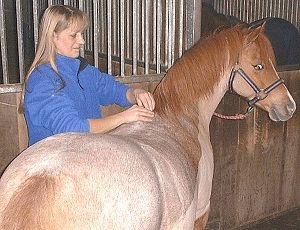McTimoney equine treatment
Does your horse have any of these problems?

- sore back
- dipping, flinching, violent tail swishing when grooming the back
- stiffness on one rein
- tail carried to one side
- poor or reduced performance
- unlevelness or unevenness of steps
- reluctance to jump
- crookedness
- headshy
- disunited canter
- problems with correct canter lead
- other gait problem
- uneven muscle tone
- bucking, rearing, not wanting saddle on, refusing to stand still when being mounted
- reluctance/difficulty maintaining an outline or engaging hindquarters
- mobility problem after a fall when other possible health problems have been ruled out by your vet
McTimoney equine therapy deals with the musculo-skeletal system, primarily the spine, and the relationship of the spine with the nervous system.
The spine is a collection of irregular bones called vertebrae, that fit together and articulate with each other to allow movement. The spine allows a range of movement such as lowering and raising the head, arching or dipping the back and bending from side to side. The horse's spine, unlike the human's or dog's, is a fairly rigid structure, the majority of movement is in the neck and in the lumbar area, just in front of where the spine connects to the pelvis (equivalent to our hips).
Bad backs and lameness problems
Wherever 2 or more bones meet is called a joint, and all joints allow a certain range of movement. Sometimes a joint can be taken to the extreme of its range of movement - through trauma such as a fall, a bad stumble, getting cast or through repetitive strain injury such as a badly fitting saddle, lameness or poor shoeing. When this happens the muscles will tighten around the joint to stop it going any further. This is just the body's own way of protecting itself. The muscle tightness will normally resolve itself through activity, such as rolling or normal spinal movements such as bending, however sometimes it can persist. This is usually because the muscle(s) have gone into spasm holding the joint slightly out of alignment, restricting the normal range of movement, decreasing flexibility and leading to a change or a problem in the way the horse normally moves.
When this stage is reached some physical symptoms will probably be seen. Back problems can range from subtle changes in the horse's performance to muscle spasm and soreness, stiffness, or lack of collection or impulsion or even a degree of inco-ordination. It could even show itself as a behavioural problem such as a cold back, bucking, not wanting to "bend" on one rein or refusing fences. When it gets to this stage an external influence such as an adjustment is required to restore normality. The equine therapist applies a short, sharp thrust to a specific area which releases muscle spasm, alleviates pain and returns the joint to its normal range of motion. This allows the horse's body to restore its own natural balance, harmony and health. After the treatment the horse should rest for 24 hours or so as it may have a reaction to the treatment. This could range from feeling better straight away to being stiff, sore or appearing worse the next day. Let the horse to take it easy for a few days and allow time for re-fittening the horse when it comes back into work.
Remember equine back problems are almost always a secondary problem to a primary cause.
Contact Jill to discuss your animals' problems and possible solutions.